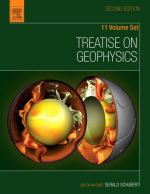Добрый день, Коллеги. Важное сообщение, просьба принять участие. Музей Ферсмана ищет помощь для реставрационных работ в помещении. Подробности по ссылке
Treatise on geophysics. Volume 11 / Трактат по геофизике. Часть 11
Near-surface geophysics (NSG) was not specifically addressed in the first edition of the Treatise on Geophysics. The decision to include a new volume in the second edition of the Treatise on Geophysics on the near surface reflects the ever-growing contribution that geophysics is making to our understanding of the outermost shell of the Earth. This growth is evidenced by the formation of a new focus group in NSG within the American Geophysical Union, the largest Earth science organization worldwide, in 2006 (Figure 1). The near surface is perhaps a somewhat nebulous term that means different things to different people. From a purely material properties perspective, one defining characteristic of the near surface is the presence of porosity and the mobile fluids filling it. These fluids increase the number of material properties needed to describe the geophysical (e.g., seismic and electrical) properties of Earth materials (e.g., see the discussion of seismic properties given by Schmitt, Chapter 11.03). However, the near surface can also be defined from a process-based perspective. For example, a critical defining metric for the near surface is the upper part of the Earth where humans interact with natural Earth systems. These interactions include the exploitation of valuable resources in the Earth and degradation of natural systems by pollution that inevitably accompanies industrialization and economic development. New interactions driven by the human response to the threat of climate change include the sequestration of carbon in subsurface reservoirs. In all cases, such human interaction modifies natural biogeochemical cycles and the physicochemical properties of Earth materials. Given that the world population is expected to reach more than nine billion by 2050 and with the rapid economic development and rising living standards in emerging economies, this human modification of natural systems can be expected to intensify. Understanding the effects of such human impacts is challenging as the near surface is a dynamic, nonlinear system characterized by multiple feedback mechanisms; consequently, our understanding of the longterm evolution of coupled human–natural systems is far from complete. <...>




